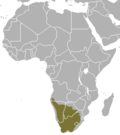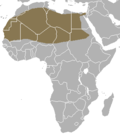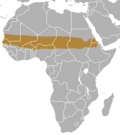Tiburaɣ
Tiburaɣ (Assaɣ ussnan: Vulpes) d yiwet n tewsit n taydiyyin yettidiren deg waṭas n yidgan deg umadal, Tawsit-a dges azal n 12 n telmas i yettwassnen yakk deg-sent d abareɣ azeggaɣ yakk d ubareɣ asafaylu.
S wassaɣ ɣer iṭan d iɣas d ikayuten, tiburaɣ ttwassnen-t d akken-iten meẓẓiy-it fell-asen, azuk-nsent yettili-d gar n 5 ar 11 kg, Akken daɣen yettili yini n usallaf-nsent yemgarad ɣef yini n tfekka, Ttidiren-t gar n sin ar kuẓ n iseggasen maca llant telmas zemren-t ad ddren-t ar mṛaw (10) n iseggasen
| Tiburaɣ | |
|---|---|
 | |
| Tasensartut | |
| Tagelda | Animalia |
| Adur | Chordata |
| Asmil | Mammalia |
| Tafesna | Carnivora |
| Tawacult | Canidae |
| tawsit | Vulpes Garsault, 1764 |
Tilmas
| Tugna | Assaɣ ussnan | S Teqbaylit | Taẓuni | Tagertilt n tẓuni |
|---|---|---|---|---|
 | V. lagopus | Abareɣ asafaylu | Abareɣ asafaylu yettidir deg yakk idgan n Urektik (Rusya, Svalbard, Island, kra n imuren deg Skandinavya, Finland, Greenland, Agafa n Kanada, d Alaska) |  |
 | V. bengalensis | Bengal fox | Bengal foxes are endemic to India and live throughout the subcontinent, and have not been placed on the endangered species list, but have become threatened by lack of native habitat due to human expansion. |  |
 | V. cana | Blanford's fox | Blanford's fox dwells in section of the Middle East including Iran and Israel, as well as Afghanistan, Egypt, Turkestan, Iran, Pakistan, and Israel. This species prefers semiarid environments. |  |
 | V. chama | Cape fox | The Cape fox is only found in the south of Africa, including Zimbabwe, Botswana, and South Africa. They thrive in semiarid and arid environments with rich grasslands. |  |
 | V. corsac | Corsac fox | Corsac foxes live in central Asia. Like V. chama and V. cana, they do best in semiarid deserts. This fox is within the holarctic clade of foxes. This clade also contains the Arctic fox, swift fox, and red fox. Their possible ancestor is V. praecorsac, meaning they may have had a much wider distribution in the past (Europe and Crimea). |  |
 | V. zerda | Aɣecter | Aɣecter yettidir deg tmura n Uneẓruf Ameqran (Tafriqt n Ugafa) am Lezzayer, Ameṛṛuk, Miẓran, Libya, Nnijer, Mali d kra n imuren deg Tazunegzirt Taserɣint |  |
 | V. macrotis | Kit fox | Kit foxes are an arid area-dwelling North American species. They are found in Oregon, Colorado, Nevada, Utah, California, New Mexico, and Texas. They also have a population in Mexico. |  |
| V. pallida | Pale fox | The pale fox lives in upper middle Africa and is an arid area-dwelling species. |  | |
 | V. rueppellii | Rüppell's fox | Ruppell's foxes are specific to northern Africa and sections of the Middle East. |  |
 | V. vulpes | Red fox, silver fox and cross fox | The red fox is the most abundant and most widely distributed species of Vulpes. They currently live in most sections of the Northern Hemisphere. They also are present in Australia, though they were brought there by humans for fox hunting in the 1830s and are considered an invasive species. This species’ ancestor (either V. alopecoides or the related Chinese V. chikushanensi) originated in the Early Pleistocene and they are most closely related to Ruppell's fox (V. rueppellii). |  |
 | V. velox | Swift fox | The swift fox is found in the western grasslands of North America, specifically Montana, Wyoming, New Mexico, Colorado, Kansas, Oklahoma, and Texas, as well as some sections of Canada. This species is most closely related to the kit fox, but lives in a different section of North America. The two can interbreed. |  |
| V. ferrilata | Tibetan sand fox | The Tibetan sand fox, as the name suggests, is endemic to the Tibetan and Ladakh plateau in Nepal, China, Sikkim, and Bhutan. This species lives at altitudes up to 5300 m and semideserts. |  |
The Arctic fox is sometimes included in this genus as Vulpes lagopus based on the definitive mammal taxonomy list, as well as genetic evidence.
Foxes of this group (including the fennec and Arctic foxes) possess eyes with pupils that retract into vertical slits in bright light.
The red fox, Ruppell's fox, and Tibetan sand fox possess white-tipped tails. The Arctic fox's tail-tip is of the same color as the rest of the tail (white or blue-gray) Blanford's fox usually possesses a black-tipped tail, but a small number of specimens (2% in Israel, 24% in the United Arab Emirates) possess a light-tipped tail. The other foxes in this group (Bengal, Cape, corsac, fennec, kit, pale, and swift) all possess black-tipped or dark-tipped tails.
This article uses material from the Wikipedia Taqbaylit article Tiburaɣ, which is released under the Creative Commons Attribution-ShareAlike 3.0 license ("CC BY-SA 3.0"); additional terms may apply (view authors). Le contenu est disponible sous licence CC BY-SA 4.0 sauf mention contraire. Images, videos and audio are available under their respective licenses.
®Wikipedia is a registered trademark of the Wiki Foundation, Inc. Wiki Taqbaylit (DUHOCTRUNGQUOC.VN) is an independent company and has no affiliation with Wiki Foundation.